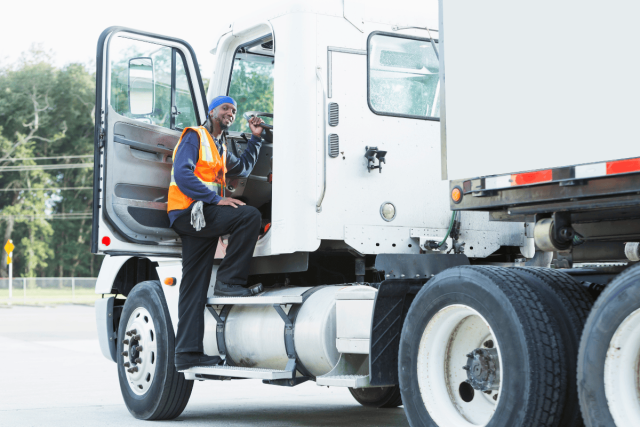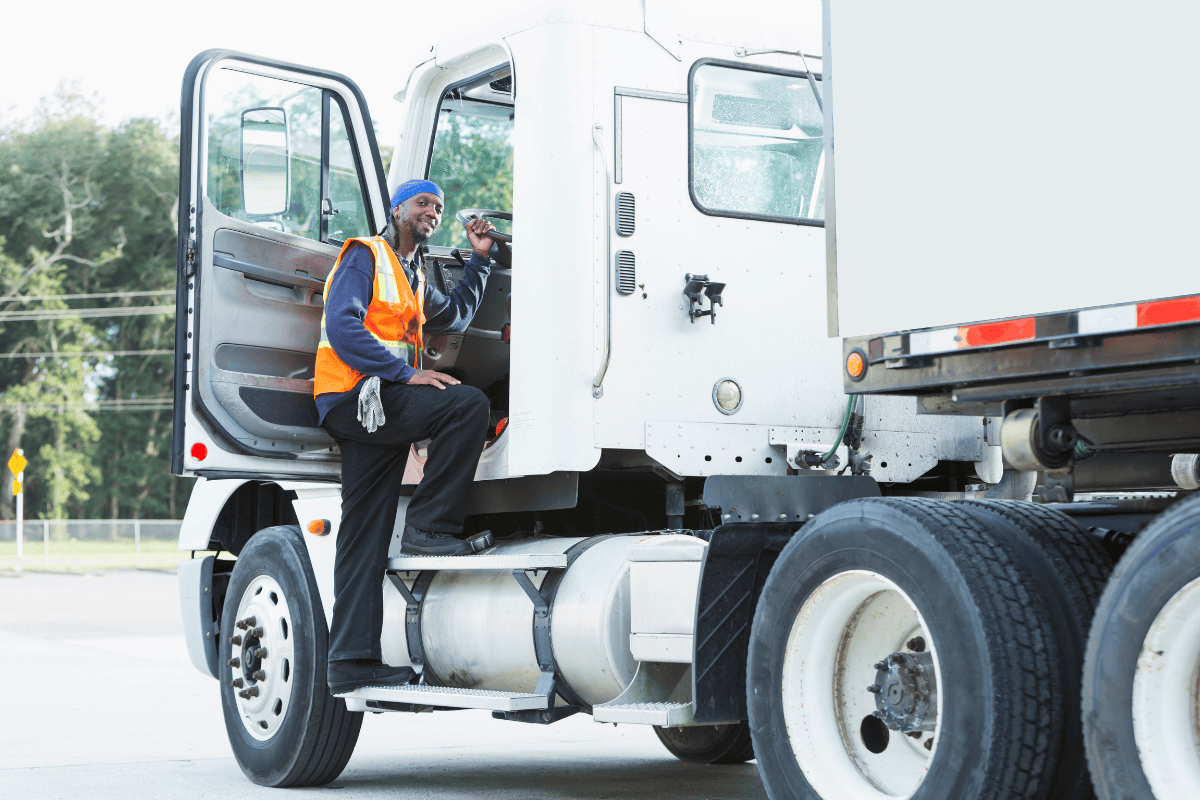
Truck Driver Safety Tips for the Real World
The alarm goes off at 4:30 AM. For the professional truck driver, this is the start of another long day moving America’s goods. By 5:30 AM, you’re at loading dock #7. The shipper is in a rush; they’re already waving you to back your tractor in, and you have haul deadlines to meet. This isn’t a made-up scenario – this is the real world of trucking.
As you move through your career, learning various truck driver safety tips will help you navigate different road conditions with ease, from the plains of Oklahoma to the hills of South Carolina. Every mile, every stop, and every decision behind the wheel presents its own set of challenges. And while safety manuals and training handbooks offer valuable knowledge, they can’t cover every unpredictable moment a trucker faces on the road.
That’s why this blog exists: to bridge the gap between textbook rules and reality. These truck driver safety tips are based on real, relatable situations. When you enroll in CDL training at a reputable truck driving school like Commercial Driving Academy, you receive expert advice from instructors who’ve been in the very situations you’ll face on the road. Whether you’re new to trucking or have thousands of miles under your belt, these tips are here to help you get started.
A Scenario-Based Guide to Your Day
It’s easy to learn truck driver safety tips in a classroom, but how do those lessons play out when you’re navigating actual road conditions? Trucking isn’t just about getting from point A to point B; it’s about constant awareness, anticipation, and decision-making. The rules you learn during your CDL training are essential, but real-world scenarios require critical thinking, focus, and adaptability. This is where real experience and training come together. By walking through a typical day of a trucker, we’ll show you how real safety decisions are made in moments that textbooks can’t always predict.
The 5 AM Start: The Pre-Trip Ritual That Prevents Disaster
Scenario: The driver is in the quiet yard before sunrise, holding a coffee in hand, going through the systematic process of checking their tractor.
The first task of the day isn’t as exciting as hitting the highway, but it could be the most crucial part of your routine. You’re about to take a large, heavy vehicle onto busy roads for hours. A systematic pre-trip inspection is essential. Not only does it prevent accidents, but it ensures your truck remains safe throughout the journey. The pre-trip inspection checklist is more than just a list of things to look for; it’s your assurance on the road that your truck is trustworthy.
During your CDL training, you’ll learn the importance of thoroughly checking your truck each day. This process includes inspecting:
- Tires: Make sure they are properly inflated
- Brakes: Ensure they are functioning smoothly
- Lights: Verify that all lights are working correctly
- Fluids: Check all necessary fluid levels
These may seem like minor details, but truck maintenance and safety play a huge role in your haul. Take the time to check each system, and never skip over any steps in your inspection, no matter how rushed you feel. This 15-minute ritual helps you mentally prepare for the road ahead, giving you a moment to focus and catch any potential issues before they become serious.
Actionable Tip: To ensure you don’t miss anything, download and print a pre-trip inspection checklist that mirrors what you learned in your training. It’ll help keep you organized and efficient every day.
8 AM, Rush Hour: Defensive Driving in Action
Scenario: The driver is merging onto a congested highway as morning traffic builds, anticipating the actions of smaller, faster vehicles.
By 8 AM, the roads are getting busy, and you’ve just entered the most unpredictable part of your day: rush hour. Merging onto a congested highway, whether it’s around Joliet or Oklahoma City, means you’re suddenly surrounded by smaller, faster vehicles. In these conditions, defensive driving techniques for truckers are crucial.
The key to navigating this situation safely lies in maintaining your “safety bubble.” It’s the space you manage around your truck to minimize the risk of collision. Always be aware of the vehicles around you, adjusting your speed and lane position based on their movements. If a car tries to cut you off, allow them to go; it’s better to yield and stay safe than to engage in a risky maneuver. Reading the “body language” of the traffic, like a car tailgating or swerving erratically, can give you clues about the driver’s intentions so you can react proactively. Trucking accident prevention is all about anticipating and being prepared for the unexpected.
Actionable Tip: Be on high alert for distracted drivers during rush hour. Look for behaviors like texting or changing lanes without signaling. Stay a few car lengths behind and avoid driving too closely to other vehicles.
1 PM, The Mid-Day Stop: Managing HOS, Fatigue, and Health
Scenario: The driver pulls into a rest stop for their mandatory 30-minute break. It’s not just about stopping—it’s about strategic recovery.
At 1 PM, you’ve been on the road for hours, and it’s time to take a break. Hours of Service (HOS) rules state that you must take breaks at regular intervals for fatigue management. But it’s not just about complying with the law; it’s about keeping yourself alert and healthy. Your mandatory 30-minute break is your time to refuel your focus and energy.
Overall, truck driver health and wellness require daily effort. Hydration and proper nutrition play a crucial role in preventing fatigue, so consider incorporating a healthy snack or meal into your routine. Steer clear of heavy foods that could make you feel sluggish. If possible, try a brief 15-minute power nap during your break. This quick rest can do wonders for your alertness during the second half of the day.
Actionable Tip: Incorporate healthy snacks, such as nuts, yogurt, or fruit, into your lunch. These provide sustained energy without the crash that comes from sugary foods or caffeine.
4 PM, The Unexpected Challenge: A Sudden Storm and a Blind-Side Back
Scenario: The weather turns unexpectedly. The delivery location is a tight, unfamiliar dock in Macon, GA that requires a difficult maneuver.
As the afternoon approaches, you’re faced with a new challenge: a sudden storm. The roads are slippery, visibility is reduced, and you need to park at a narrow, unfamiliar dock that requires difficult backing. This scenario emphasizes the importance of safe driving practices in all weather conditions.
Before the weather becomes hazardous, adjust your speed and following distance. Take the wet or icy road conditions into account and drive accordingly. In inclement weather, it’s crucial to slow down and give yourself more space to react.
Backing a tractor-trailer into a tight dock in these conditions adds even more complexity. The GOAL method (Get Out and Look) is key here. Never be afraid to get out and check your surroundings. Even experienced drivers use this technique when something “doesn’t feel right.” Communication with the dock crew is also essential. Use clear hand signals to make the process smoother and safer.
Actionable Tip: Before backing into any dock, do a quick mental checklist. Ask yourself: “Can I see clearly? Is the space wide enough? Are there obstacles I need to avoid?”
Ending the Day as Safely as It Began
As the truck comes to a final stop for the night, the driver wraps up their post-trip log and mentally prepares for the next day. It’s been a long day filled with wise choices, each one adding up to a safe haul.
Professional safety isn’t about one quick maneuver or a single rule followed. It’s about making consistent, well-thought-out decisions. Check your rig thoroughly, stay focused in traffic, remain sharp through the slow periods, and adjust calmly when conditions change. These are all vital factors working together to ensure the safety of everyone on the road.
At Commercial Driving Academy, we teach more than just how to pass a test; we train drivers for the reality of the road, where experience, awareness, and good habits matter most. That’s why safety is built into every lesson—because being a professional driver means protecting yourself and everyone around you.
Ready to Start Your Truck Driving Career?
Commercial Driving Academy has locations in South Carolina, Georgia, Illinois, and Oklahoma. Fill out the form on this page or call us at (844) 477-8868 to learn more about our CDL training programs.

